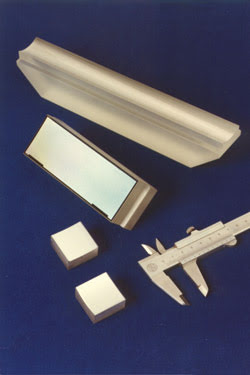Dr. John R. Gilchrist and Bruno Touzet
Demand for higher-resolution and longer-wavelength gratings drives
novel holographic and ion-etched designs for use in applications from laser pulse
compression to wavelength division multiplexing systems.
Up until the mid-1960s, mechanically ruled diffraction gratings with approximately
1800-g/mm ruling density were considered to be the state of the art in spectroscopy.
By the late ’60s, scientists had developed diffraction gratings by forming
a hologram ruling in photoresist. Soon they also were able to make aberration-corrected
gratings using a holographically produced variable line-spacing structure. Such
gratings have been available for almost 30 years for use in UV to visible spectroscopy,
and in meeting the demands of synchrotron and spaceflight applications.
Subsequent developments in ion-etching techniques
led to the combination of holographic gratings with ion-etched blazed profiles that
were close in diffractive efficiency to those achieved by mechanical ruling, but
with superb stray-light performance and no ghost artifacts. These gratings are often
the best choice for ensuring that a spectrometer has the highest signal-to-noise
ratio.
Today’s state-of-the-art diffraction
gratings are employed in applications from soft x-ray spectroscopy to ultrahigh-energy
pulsed laser experiments where operation up to the petawatt level is required. Scientists
at Jobin Yvon recently demonstrated high-ruling-density transmission gratings engraved
directly into fused silica for the Laser MegaJoule project, a French government
initiative similar to the Lawrence Livermore National Laboratory’s National
Ignition Facility in Livermore, Calif.
Each grating is 420 x 470 mm in area
and performs the functions of wavelength separation, third harmonic at 351 nm from
the fundamental at 1053 nm, and beam steering. It also focuses the beam as a lens
to a small spot that is approximately 400 μm in diameter. Special holographic
recording is used to produce the gratings with a high-aspect-ratio laminar profile.
After recording, the photoresist is developed, leaving a mask through which ion
etching can be made. With a 2500-g/mm-density laminar grating, groove depths up
to 1 μm are achievable, resulting in grating efficiencies as high as 90 to
95 percent — essential for the transmission of these intense laser pulses.
By recording curved and nonequidistant
grooves, the transmission grating can be adjusted to provide a focusing and a dispersive
effect, allowing laser designers to minimize the number of optical elements in each
beam line. Laser MegaJoule has 240 such beam lines that concentrate their light
onto a fusion target to produce 500-TW pulses in 3 ns and sample temperatures as
high as 108 K. Diffractive optics is one of the key enabling technologies for this
project.
In the same area of high-energy lasers,
it’s possible to produce large pulse-compression gratings engraved into high-damage-threshold
multilayer dielectric coatings. These new gratings offer important advantages in
comparison with the more classical gold-coated pulse-compression gratings: higher
efficiency, in the 93 to 98 percent range, along with a doubled laser-induced damage
threshold.
Scientists continue to research grating
materials, groove profiles and distributions, and manufacturing techniques for mastering
gratings using holographic and etching techniques. In the process, we are seeing
many exciting possibilities for designing spectrometer systems with high resolution,
high efficiency and minimal stray light.
An important step was the development
of spectrometers that allowed the grating to be the only optical element. In this
case, the grating can be concave-spherical or -toroidal and aberration-corrected.
This enables the design of instruments for the soft x-ray as well as for the UV
to the infrared regions. Although this concept is not new, it has been developed
to a very high level of performance for both monochromator and spectrograph applications.
Indeed, convex gratings are commonly used in Offner spectrograph designs, which
provide excellent spectral resolution and imaging and stray light performance for
multitrack measurements such as multipoint process monitoring for pharmaceutical
manufacturing.

Use of elements such as these toroidal and
aberration-corrected diffraction gratings makes possible the design of instruments
for the soft x-ray as well as for the UV to the IR regions.
In the next three years or so, the
continual development of novel holographic designs and ion-etched techniques is
expected to deliver high-efficiency gratings for laser-pulse compression, and spectrometers
in the extreme-UV for synchrotron and space applications, and in the infrared for
semiconductor analysis and dispersive gas sensing. With an upswing in the telecommunications
industry, the requirement for higher-resolution and longer-wavelength gratings
also will drive novel designs for use in wavelength division multiplexing systems.
The diffraction gratings market is
steadily expanding as instrument designers move away from filter-based instruments
and toward wavelength-dispersive instruments that can measure a far richer spectroscopic
signal. Diverse market segments exist — from large laser gratings to small
monochromator gratings — and run into many hundreds of thousands of gratings
per year worldwide with prices per unit ranging from $100,000 and more to as low
as $100. Development focus continues on the multilayer dielectric-type gratings
and on holographic designs for near-infrared operation.
Meet the authors
John R. Gilchrist is director of the custom optics
group at Jobin Yvon Inc. in Edison, N.J. He obtained his doctorate in applied physics
from Strathclyde University.
Bruno Touzet is sales and marketing
manager for the OEM and custom optics division of Jobin Yvon SAS in Longjumeau,
France.